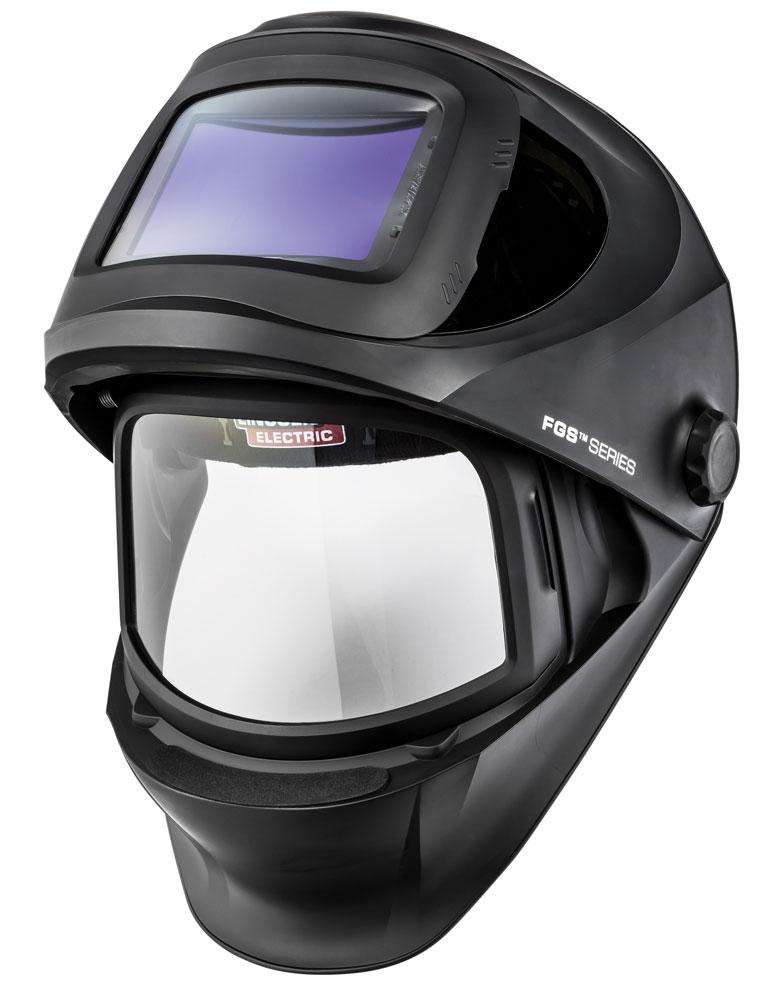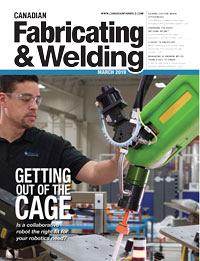Associate Editor
- FMA
- The Fabricator
- FABTECH
- Canadian Metalworking
What to look for in a welders helmet
A look at welding helmet safety, ergonomics, and tech trends
- By Lindsay Luminoso
- Updated May 18, 2023
- March 29, 2019
- Article
- Welding
Helmets are crucial to operator safety and provide protection in welding and grinding applications. A number of options are available on the market with wide-ranging features. But not all welding helmets are created equal. It’s important to understand current and future application and environment needs when choosing a welding helmet.
One of the foundational features of any helmet is safety and compliance. In the United States, welding helmets need to meet ANSI Z87.1 standards, and in Canada the helmets need to be CSA Z94.3-compliant.
"Welding helmets are designed to meet these standards; the industry is really focused on protecting the welder," said Karena Dyer, product manager, welding safety and health, Miller Electric Mfg. LLC, Appleton, Wis.
General standards ensure that the helmet lens protects the welder from anything that could affect the eyes. According to Dyer, this includes ultraviolet and infrared filtering regardless of the shade setting. Safety must be a top priority.
"We’ve also found that when a welder is choosing a helmet, it’s very much based on performance," said Guy Shelverton, global product manager, welding PPE, ESAB, Annapolis Junction, Md. "One of the biggest trends we see is that most welders pick automatic darkening helmets with an LCD as opposed to the historical passive helmets that just have a mineral glass."
Welders Helmet Lens Types
"One of the most important features of a welding helmet is the type and quality of the lens," said Chase Rutti, product manager of personal protective equipment, Lincoln Electric Co., Cleveland, Ohio.
"The two types of lenses are passive, which are normally made of a polycarbonate plastic, and autodarkening, which is generally made of a liquid crystal display (LCD) glass," said Rutti. He added that autodarkening lenses are the preferred type in the market today as they provide greater functionality and improved productivity when compared to its passive counterpart.
Dyer also noted that optical clarity of the surrounding environment is important to welders. It’s not just about the arc and puddle but seeing the area before and after the arc is struck, as well as the surrounding workpiece.
"Obviously, larger viewing size is always welcome," said Shelverton. "Welders generally want a bigger viewing area when they’re looking for an LCD. But there’s a compromise—the bigger the viewing area, the heavier and bulkier the helmet becomes. It’s a trade-off."
When investigating an LCD, welders should ask a number of questions, Shelverton said, such as How clear can I see through the LCD? How clear can I see the workpiece? How well can I see during, before, and after the weld? Before welders strike the arc, they need to see what exactly they are doing in order to set up correctly.

To pick the right helmet, it's important for welders to know the required shade range they need for all of their applications. Chart courtesy of Lincoln Electric.
A shade number indicates the intensity of light radiation which is allowed to pass through the lens to one’s eyes. Shade numbers for welding helmets range from 4-13, with shades 4-8 primarily used for grinding and cutting and 9-13 used for welding.
However, knowing the environment in which the majority of the welding is going to take place is equally important and directly affects the autodarkening capabilities. If welding will be done predominantly outside or in areas of lots of sunlight, it’s important to find a helmet with the technology to adapt the optical view. For example, Dyer explained some welding helmets offer technology that eliminates interference of the autodarkening filter (ADF) sensors even when the sensors are blocked, when welding outdoors in direct sunlight, or when welding out of position. The helmet is designed to detect the electromagnetic field generated from the welding arc and darken only when necessary, eliminating nuisance flashes of the ADF lens flickering from clear to dark state.
"Fast-forward 10 years from now, the future could be that a welding helmet might not be viewed through an LCD at all," said Shelverton. "It could be that the welder’s view is projected inside the helmet using external cameras providing a live feed of the workpiece, where the welder isn’t actually looking directly at the weld. The projected direct feed also could provide additional information in an augmented reality view. There could be thermal imaging, a heads-up display, and linking technology all incorporated. It’s not current technology, but there is the potential."
Having a clear view will give the welder the ability to accurately manipulate the weld, whether that’s moving faster, altering the work angle, or moving closer to the weld to improve the overall quality.
True Colour Welding Helmet Technology
A more recent advancement in optic technology is the development of autodarkening lenses which allow a wider range of visible light to pass through the filter. This technology varies by manufacturer but is often referred to as true colour or real colour.
Rutti cautioned that welders should inquire about in what state the true-colour feature occurs. For example, some manufacturers highlight true colour in the inactive state. In an autodarkening helmet, the inactive state occurs when the sensors do not detect an arc. The autodarkening shade at the inactive state is usually a #3 or #4, which is already relatively easy to see through. The benefit of real or true colour is during the weld state, when autodarkening transitions to anywhere from shade #8 to #13.
Without true-colour technology, it can be very hard to differentiate between red and orange. According to Rutti, older technology tends to have lots of colour saturation, increasing contrast and making it hard to distinguish among colours.
"True colour also helps reduce training time," said Rutti. "Without the technology, welders often couldn’t see what they are missing or fine-detailed mistakes. Being able to have high-definition clarity allows the welder to see and prevent potential weld defects from occurring."
However, true-colour technology is not only about productivity gains; it also helps reduce eye strain. Welders often wear their helmet to weld for several hours per day. Looking at anything blurry for a prolonged period of time can cause headaches and other health-related issues, including eye strain. True colour provides relief from this problem by clearly displaying natural colours and clarity.
Grind Mode
Beyond high-definition optics and lens technology, welders need to determine what applications and processes they may perform. In today’s shop environment, a welder may not be responsible for just welding, but cutting and grinding as well.
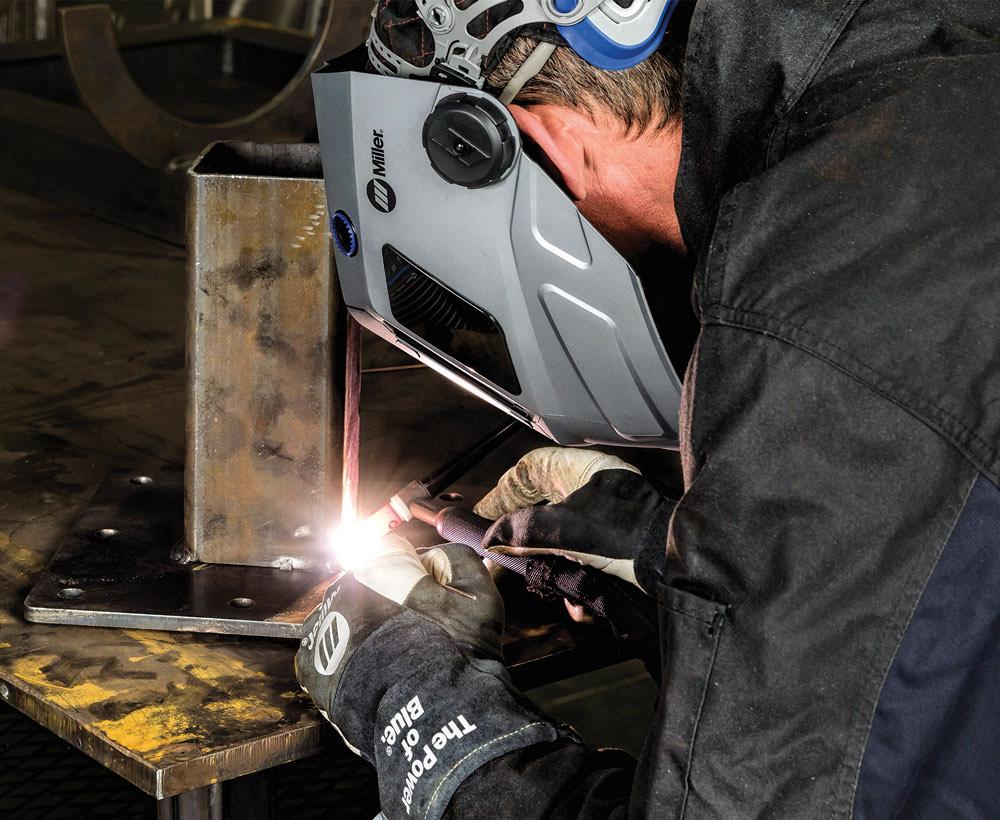
Welding helmets should be designed in such a way that they properly distribute the weight across the entire surface, eliminating pressure points and keeping the welder comfortable. Photo courtesy of Miller Electric.
"The next technological advancement we see is in the integration of a grind shield," said Rutti. "This makes a welding helmet more versatile as its capabilities are increased. On these new style of welding helmets, the autodarkening lens is positioned in front of a clear grind shield. This lens is connected to a hinge mechanism which can be rotated upward to expose the clear grinding shield."
Right now, if a welder is performing grinding operations, they often take off their welding helmet and put on a clear grind shield. Having an integrated welding helmet with a grinding lens eliminates the need for additional equipment.
"However, some helmets also offer cut, weld, and grind modes," said Dyer. "This feature allows for the user to click a button and the helmet transitions to the correct mode shade. This also keeps the helmet on the welder at all times for improved safety and productivity."
Personal protective equipment (PPE) that has the versatility to swiftly transition between various modes offers time savings and decreased risk of injury from having to switch the PPE.
Welders Helmet Ergonomics
"The next big thing is really comfort," said Shelverton. "Finding a helmet that offers constant balance is really important. So is overall weight. If it’s a heavy helmet, a welder will feel the strain on the neck and the head the longer the helmet is used."
Comfort and ergonomics revolve around a helmet’s centre of gravity. The headgear should be designed in such a way that it properly distributes the weight across the entire surface, eliminating pressure points and keeping the welder comfortable. Rutti explained that a welding helmet that keeps most of its weight in the front, where the lens is, may cause significant strain. That’s why manufacturers place emphasis on designing for ergonomics and distributing weight across the operator’s head.
Shelverton added that traditional welding helmets have always been bulky and square. But there has been a push away from this style of helmet to a non-traditional design that resembles a tactical, military-looking helmet.
Today’s helmets are designed to be lightweight and compact, while still offering the necessary features.
"The shells are made of material that protects the welder while still being lightweight," said Dyer. "The colour of the shell can also be a factor when it comes to comfort and ergonomics. If the shell is grey in colour, it will reflect ambient heat from the welding process, and in high-amperage welding where heat is extreme, this can make a difference in operator comfort and productivity."
Operating Cost
It’s no surprise that incorporating new and improved features will drive up the price of a helmet, and initial cost is a big factor. However, having an ill-equipped welding helmet can be even more costly in the long run if the welder is constantly needing to fix mistakes or needs to limit welding time because of strain and discomfort.
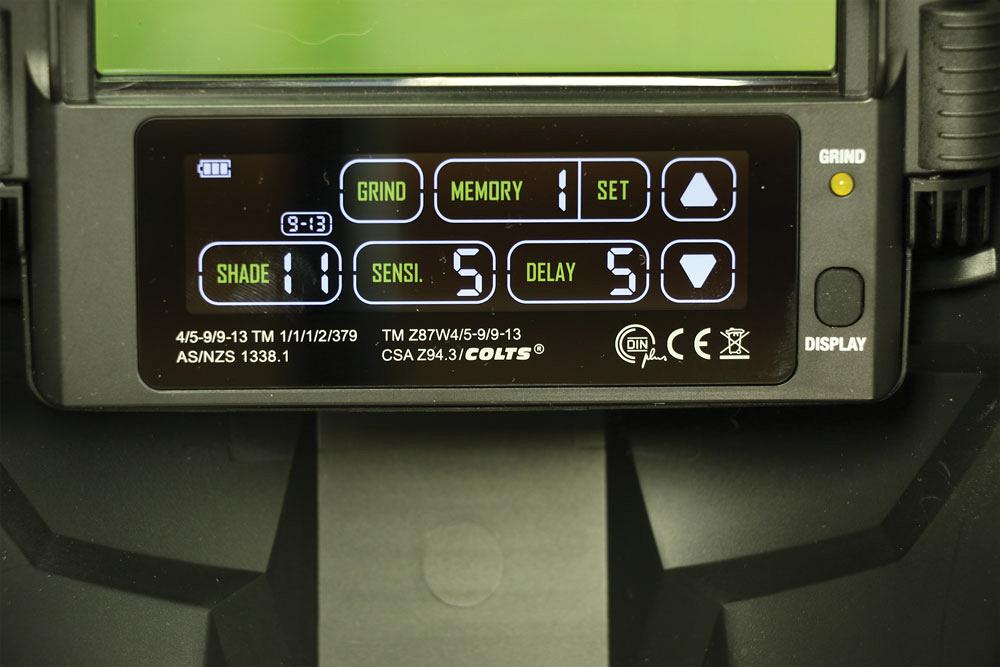
Some helmets also offer cut, weld, and grind modes. The welder can click a button and the helmet transitions to the correct mode shade. Photo courtesy of ESAB.
"Welders should look at the cost spectrum associated with the helmet, especially when it comes to consumables and operating cost," said Shelverton. "Understanding the costs of spare parts is important, because many of the parts need to be replaced frequently, depending on usage."
Shelverton gave the example of the front cover polycarbonate lens, which sits in front of the LCD screen to protect it from welding debris and molten metal. Depending on usage, it could require frequent changeover. The sweatband is also something that requires regular replacement. The costs and availability of spare parts can make or break a helmet’s overall effectiveness. If the welder cannot easily get spare parts required to weld safely, his helmet is effectively rendered useless.
Powered Air Purifying Respirator (PAPR)
"On the welding side of things, respiratory helmets are considered PAPRs," said Rutti. "PAPRs are approved by National Institute for Occupational Safety and Health (NIOSH) and regulated by the Occupational Safety and Health Administration (OSHA)."
A PAPR is a welding helmet with the ability to create a positive-pressure breathing zone within the helmet, providing respiratory protection for the wearer. This system comprises a specialized helmet, blower, HEPA filter, and personalized mounting harness. The PAPR blower draws ambient air from the environment, filters out particulate at least 0.3 microns in size, and transfers the filtered air into the welding helmet at a flow rate of at least 180 litres per minute.
According to Rutti, there is a definite increase in demand for PAPRs. He estimates that approximately 5 to 10 per cent of professional welders use a PAPR. He expects that number to gradually increase over time due in part to the reduced exposure levels to various constituents of the fume imposed by OSHA and recommended by other organizations.
"The younger generation is more aware and concerned about the dangers of welding fumes," said Shelverton. "They are more in tune with environmental safety and health risks. I think in time we will see a change in the legislations that govern the use of PAPR. I think that it probably will be mandatory in Europe first, and then North America and other regions will follow."
Tech Trends in Welding Helmets
"There are many new, exciting innovations available on the market," said Dyer. "For example, features that track the arc count and arc time help provide the weld operator immediate feedback on their welding performance when measuring arc-on time for productivity. Evaluations can then be made within their weld environment, weldment, and processes to determine if any adjustments could be made for improvement. This really helps with increased productivity and is something new we are seeing more and more of."
The next wave of welding helmet tech seems to be centred on productivity. A recent trend Rutti has seen in the market is the integration of external knobs or buttons on the helmet shell which control the helmet’s mode or shade. This simplifies the adjustment of a welding helmet that is used for multiple fabrication processes and at a variety of amperage ranges.
As you look multiple years into the future, Rutti expects welding helmet technology to incorporate a heads up display (HUD), which overlays information onto the workpiece. Rutti cautioned that while the concept has existed for many years, significant challenges need to be resolved before this technology can be costeffectively brought to market in a standard welding helmet.
The experts agree that the future of welding helmets is in their ability to be connected, in real time, with additional PPE and equipment. Smart technology is becoming more prominent on the shop floor, and welding PPE is slowly catching up with this trend.
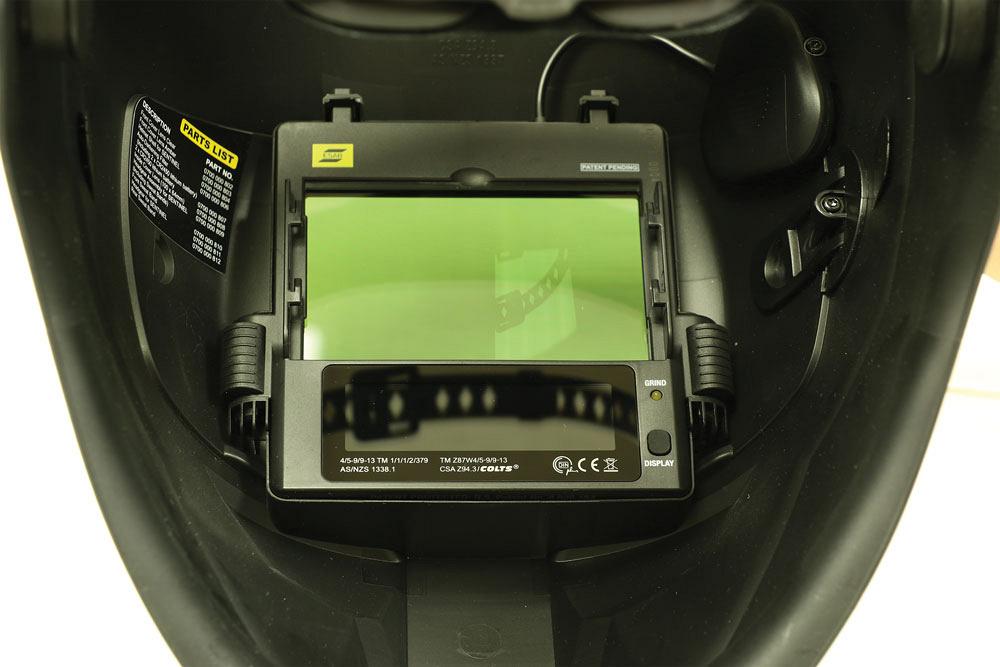
Some helmets also offer cut, weld, and grind modes. The welder can click a button and the helmet transitions to the correct mode shade. Photo courtesy of ESAB.
"We see lots of opportunity when it comes to smart technology and connectivity," said Shelverton. "This could be anything from connecting the helmet to a smartphone that’s then linked to an app which provides real-time data inside the helmet. There is the potential for voice activation, where the welder can change and manipulate settings on the machine without needing to go to it."
Associate Editor Lindsay Luminoso can be reached at lluminoso@canadianfabweld.com.
ESAB, www.esabna.com
Lincoln Electric Co., www.lincolnelectric.com
Miller Electric Mfg. LLC, www.millerwelds.com
About the Author

Lindsay Luminoso
1154 Warden Avenue
Toronto, M1R 0A1 Canada
Lindsay Luminoso, associate editor, contributes to both Canadian Metalworking and Canadian Fabricating & Welding. She worked as an associate editor/web editor, at Canadian Metalworking from 2014-2016 and was most recently an associate editor at Design Engineering.
Luminoso has a bachelor of arts from Carleton University, a bachelor of education from Ottawa University, and a graduate certificate in book, magazine, and digital publishing from Centennial College.
subscribe now


Keep up to date with the latest news, events, and technology for all things metal from our pair of monthly magazines written specifically for Canadian manufacturers!
Start Your Free Subscription- Trending Articles
Aluminum MIG welding wire upgraded with a proprietary and patented surface treatment technology

CWB Group launches full-cycle assessment and training program

Achieving success with mechanized plasma cutting

Hypertherm Associates partners with Rapyuta Robotics

Brushless copper tubing cutter adjusts to ODs up to 2-1/8 in.

- Industry Events
MME Winnipeg
- April 30, 2024
- Winnipeg, ON Canada
CTMA Economic Uncertainty: Helping You Navigate Windsor Seminar
- April 30, 2024
- Windsor, ON Canada
CTMA Economic Uncertainty: Helping You Navigate Kitchener Seminar
- May 2, 2024
- Kitchener, ON Canada
Automate 2024
- May 6 - 9, 2024
- Chicago, IL
ANCA Open House
- May 7 - 8, 2024
- Wixom, MI














